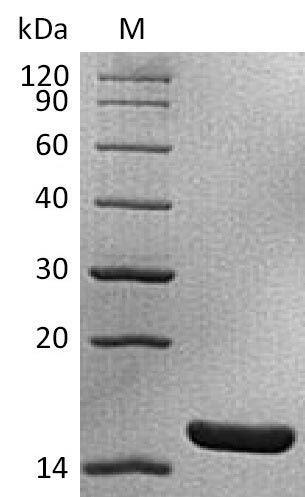The gene fragment encoding the mouse Il1a (115-270aa) was co-cloned into an expression vector and then introduced into E.coli cells for protein expression. The recombinant mouse Il1a was obtained from culture supernatants of transfected E.coli cells and purified using affinity chromatography. Its purity is over 95% as measured by SD-PAGE and its endotoxin content is less than 1.0 EU/μg as determined by the LAL method. This recombinant Il1a protein has been validated to be biologically active, with the ED50 of less than 20 pg/mL as determined in a cell proliferation assay using mouse D10S cells.
Mouse Il1a protein is a cytokine that plays a crucial role in inflammatory responses and immune regulation in mice. Studies have shown that Il1a is involved in various biological processes in mice, such as skin inflammation, oocyte aging, macrophage function, embryo implantation, and regulation of gene expression.
In mouse models of skin inflammation, such as acute skin inflammation induced by PMA, increased Il1a mRNA production is observed, indicating its involvement in inflammatory processes [1]. Il1a has also been implicated in embryo implantation, where it upregulates the expression of certain genes in mouse uterine stromal cells [2]. Il1a and IL6 expression levels are higher in normal and activated mouse blastocysts compared to dormant ones, indicating their involvement in early developmental processes [3].
Furthermore, Il1a deficiency has been shown to increase the expression of follicle-stimulating hormone receptors in granulosa cells, suggesting a role in reproductive processes [4]. Il1a is upregulated in dendritic cells following incubation with immune complexes, indicating its involvement in immune responses [5].
References:
[1] P. Martin, J. Goldstein, L. Mermoud, A. Díaz-Barreiro, & G. Palmer, Il-1 family antagonists in mouse and human skin inflammation, Frontiers in Immunology, vol. 12, 2021. https://doi.org/10.3389/fimmu.2021.652846
[2] A. Fouladi-Nashta, L. Mohamet, J. Heath, & S. Kimber, Interleukin 1 signaling is regulated by leukemia inhibitory factor (lif) and is aberrant in lif−/− mouse uterus1, Biology of Reproduction, vol. 79, no. 1, p. 142-153, 2008. https://doi.org/10.1095/biolreprod.107.065219
[3] J. Shakerzadeh, M. Movahedin, A. Eidi, N. Roodbari, & K. Parivar, Forced suppression of let-7a-5p in mouse blastocysts improves implantation rate, Reproductive Sciences, vol. 29, no. 6, p. 1730-1737, 2021. https://doi.org/10.1007/s43032-021-00659-3
[4] S. Uri-Belapolsky, I. Miller, A. Shaish, M. Levi, D. Harats, L. Ninio-Manyet al., Interleukin 1-alpha deficiency increases the expression of follicle-stimulating hormone receptors in granulosa cells, Molecular Reproduction and Development, vol. 84, no. 6, p. 460-467, 2017. https://doi.org/10.1002/mrd.22799
[5] N. Montfoort, P. Hoen, S. Mangsbo, M. Camps, P. Boross, C. Meliefet al., Fcγ receptor iib strongly regulates fcγ receptor-facilitated t cell activation by dendritic cells, The Journal of Immunology, vol. 189, no. 1, p. 92-101, 2012. https://doi.org/10.4049/jimmunol.1103703






